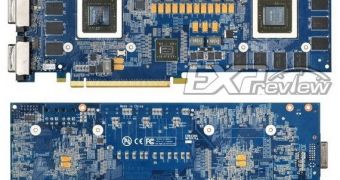Most graphics-card news in the past few months has revolved around the DirectX 11-capable cards from AMD and the still-unreleased Fermi-based GF100 video card from NVIDIA. However, an as-of-yet unheard of and rather unexpected development has taken the form of another dual-GPU card, this time NVIDIA-based. Galaxy has been designing a dual-GPU GTS 250 graphics adapter, which is rather interesting, due to its novelty, even despite the fact that recent developments make a new DirectX 10 model rather unappealing.
The card that Galaxy has been developing uses two low-power G92-426 GPUs, each of which is provided with 1GB of GDDR3 memory. The card itself has a large, blue PCB and features a 2x256-bit memory interface. The device has 128 Processing cores on each graphics processor and also boasts a PCIe bridge chip and dual-DVI outputs. Furthermore, the product employs Bussman chokes and uses a 6-phase design, thus appearing more suited to overclockers.
A move like this one would be quite unexpected in an industry where the jump to next-generation graphics has already been made. Advanced Micro Devices has ruled the DirectX 11 graphics market for months and NVIDIA's upcoming next-generation CUDA aims to break the former's monopoly. Even though it is a dual-GPU, the ability of such a card to survive in such market conditions is highly questionable.
Considering these facts, Galaxy's product is not exactly seen as a strong presence, even though its actual graphics processing capabilities will be high. Even the fact that it is aimed at overclockers may turn out to be disadvantageous in some cases, as most enthusiasts have been going for AMD cards when wanting to push the limits of their systems. In fact, a good marketing performance on the part of this dual-GPU card would be possible in case the GT200 shortages continue.
Among the disadvantages of this product, compared to the recent releases from Advanced Micro devices, are the overgrown PCB and the lack of support for Quad SLI. It is still rather unclear whether the device will ever become available.

 14 DAY TRIAL //
14 DAY TRIAL //